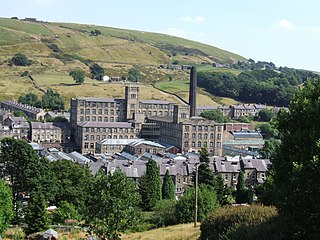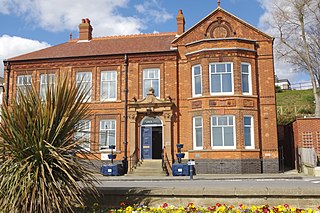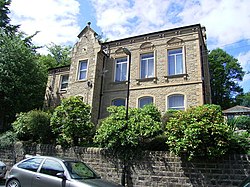
Holmfirth is a town in the Metropolitan Borough of Kirklees, West Yorkshire, England. It is located 6 miles (9.7 km) south of Huddersfield and 14 miles (23 km) west of Barnsley; the boundary of the Peak District National Park is 2 miles (3.2 km) to the south-west. The town is sited on the A635 and A6024 roads in the Holme Valley, at the confluence of the River Holme and Ribble. It mostly consists of stone-built cottages nestled on the eastern slopes of the Pennine hills.

Marsden is a large village in the Colne Valley, in the metropolitan borough of Kirklees, West Yorkshire, England. It is in the South Pennines close to the Peak District which lies to the south. The village is 7 miles (11 km) west of Huddersfield at the confluence of the River Colne and Wessenden Brook. It was an important centre for the production of woollen cloth. In 2020, the village had an estimated population of 3,768.

Slaithwaite is a town and former civil parish in the Colne Valley area of the metropolitan borough of Kirklees, in West Yorkshire, England. Historically part of the West Riding of Yorkshire, it lies in the Colne Valley, lying across the River Colne and the Huddersfield Narrow Canal, approximately 5 miles (8 km) south-west of Huddersfield.

Huddersfield is a market town in the Kirklees district in West Yorkshire, England. It is the administrative centre and largest settlement in the Kirklees district. The town is in the foothills of the Pennines. The River Holme's confluence into the similar-sized Colne is to the south of the town centre which then flows into the Calder in the north eastern outskirts of the town.

The Colne Valley is a steep sided valley on the east flank of the Pennine Hills in the English county of West Yorkshire. It takes its name from the River Colne which rises above the town of Marsden and flows eastward towards Huddersfield.

Colne Valley is a constituency represented in the House of Commons of the UK Parliament since 2019 by Jason McCartney of the Conservative Party.

Royds Hall Academy is a mixed secondary school for pupils aged 11 – 16. It is located in Huddersfield, West Yorkshire, England, and on the north side of the Colne Valley towards Milnsbridge.

Nettleton Hill is a hamlet in the Kirklees district in the English county of West Yorkshire. It is situated west of the town of Huddersfield, north of Scapegoat Hill and south of Pighill Wood. Longwood reservoir is to the east of the settlement. Nettleton Hill is part of the Golcar ward and of the HD7 postcode district.

Lewisham Town Hall is a municipal building in Catford Road, Lewisham, London. The oldest part of the facility, the curved municipal offices, which is the headquarters of Lewisham London Borough Council, is a Grade II listed building.

Elland Town Hall is a municipal building in Southgate, Elland, West Yorkshire, England. The structure, which was primarily used as an events venue, is a Grade II listed building.

Knottingley Town Hall is a municipal building in Weeland Road, Knottingley, West Yorkshire, England. The structure, which served as the headquarters of Knottingley Urban District Council, now operates as a community centre.

Horbury Town Hall is a former municipal building in Westfield Road, Horbury, West Yorkshire, England. The structure, which is now used as business centre, is a locally listed building.

Hanley Town Hall is a municipal building in Albion Square in Hanley, Staffordshire, England. The building, which is used as the local register office, is a Grade II listed building.

Felixstowe Town Hall is a municipal building in Undercliff Road West, Felixstowe, Suffolk, England. The building is the meeting place of Felixstowe Town Council.

Meltham Town Hall is a municipal building in Carlile Street in Meltham, West Yorkshire, England. The building, which formerly operated as the offices of Meltham Urban District Council, is now The Crossroads Centre, which operates the local foodbank.

Liversedge Town Hall is a former municipal building and town hall on Knowler Hill in the town of Liversedge, West Yorkshire, England. The building, which formerly operated as the offices of Liversedge Urban District Council, is now used as private residential accommodation.

Sowerby Bridge Town Hall is a former municipal building in Town Hall Street in Sowerby Bridge, West Yorkshire, England. The building, which was initially used as the offices of the local board of health and as a public events venue, then as the home of the local Liberal Club and later as a bank branch, is a Grade II listed building.

Denny Town House is a municipal building in Glasgow Road, Denny, Falkirk, Scotland. The structure is used by Falkirk Council for the provision of local services.

Carlow Town Hall is a municipal building in Centaur Street, Carlow, County Carlow, Ireland. The building accommodated the offices of Carlow Town Council until 2014 but is now used as a community events venue.





















